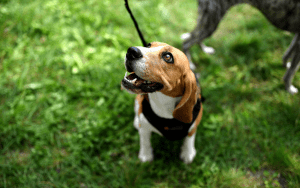
Step-by-Step: How to Walk Your Puppy on a Loose Leash
Your dog will learn in no time with this how-to guide!
Teaching your puppy to walk on a loose leash starts the very first time you clip the leash to their collar. While it may be the thousandth time you’ve put a leash on a dog before, keep in mind this is an entirely new experience for your puppy. You should keep the introduction short and follow the rule, “work on one thing at a time.”
Step 1: Backward Motion
Make sure you have plenty of reward kibble or small treats (a kibble pouch makes keeping it close easy). For your first training session, turn and face your puppy. Take three steps backwards and invite your puppy to come towards you with a happy voice. When the puppy gets to you, reward them with a treat or praise. Repeat the exercise by walking backwards a few feet at a time. If your puppy becomes distracted by the leash, chews on it, or tries to back away, get their attention with a treat, and/or use a lure to get their focus on you. Your first introduction should last about 3 – 5 minutes.
Step 2: Adding Forward Motion
Once your puppy is confidently following as you back up, it’s time for the next step: Adding forward motion. Begin by taking three steps backwards. As your puppy approaches you, lure your puppy to your left side with your left hand and take three steps forward. Your puppy should turn toward you and fall into position with their ear even with your leg. As your puppy turns and begins to walk next to you, give them a treat and plenty of praise. Continue with your forward motion, praising your puppy and rewarding them with another treat, then end the exercise.
TIP 1: Always treat your puppy with the hand that is closest to them. Never cross-treat your puppy (using the hand on the opposite side of your body) as this will pull your puppy out of position.
TIP 2: If your puppy gets distracted or loses focus on you, use their name or a happy sound and take three or more steps backwards. This should refocus your puppy on you and give you an opportunity to reward them for re-focusing and walking toward you.
Step 3: Starting with Forward Motion
Over the course of your sessions, as your puppy becomes patterned to walk in position next to your leg, you can progress to walking forwards from the first step; then, moving backwards becomes a tool you can use to refocus your puppy and correct their position. Do this anytime the puppy becomes distracted or moves out of position.
Step 4: Introducing a Pivot
For an older puppy that knows the expectation of a walking position, you can introduce a pivot to refocus them when they break position, instead of taking a step back. A pivot works by turning 180 degrees into your puppy, likely bumping into them as you turn. This will get your puppy’s attention and push your puppy back into an appropriate position. You may use a food reward at this stage and should reward the puppy often.
Remember, anytime your puppy wanders out of position or gets distracted it’s an opportunity to refocus, reengage and reward them.
About Canine Companions for Independence®
Canine Companions for Independence® is the largest non-profit provider of highly trained assistance dogs with six regional training centers across the country. Established in 1975, Canine Companions provides professionally trained assistance dogs to children, adults, and veterans with disabilities and is recognized worldwide for the excellence of its dogs, and the quality and longevity of the matches it makes between dogs and people. There is no charge for the dog, its training, and ongoing follow-up services. For more information, visit cci.org.
 from KONG Company
from KONG Company



